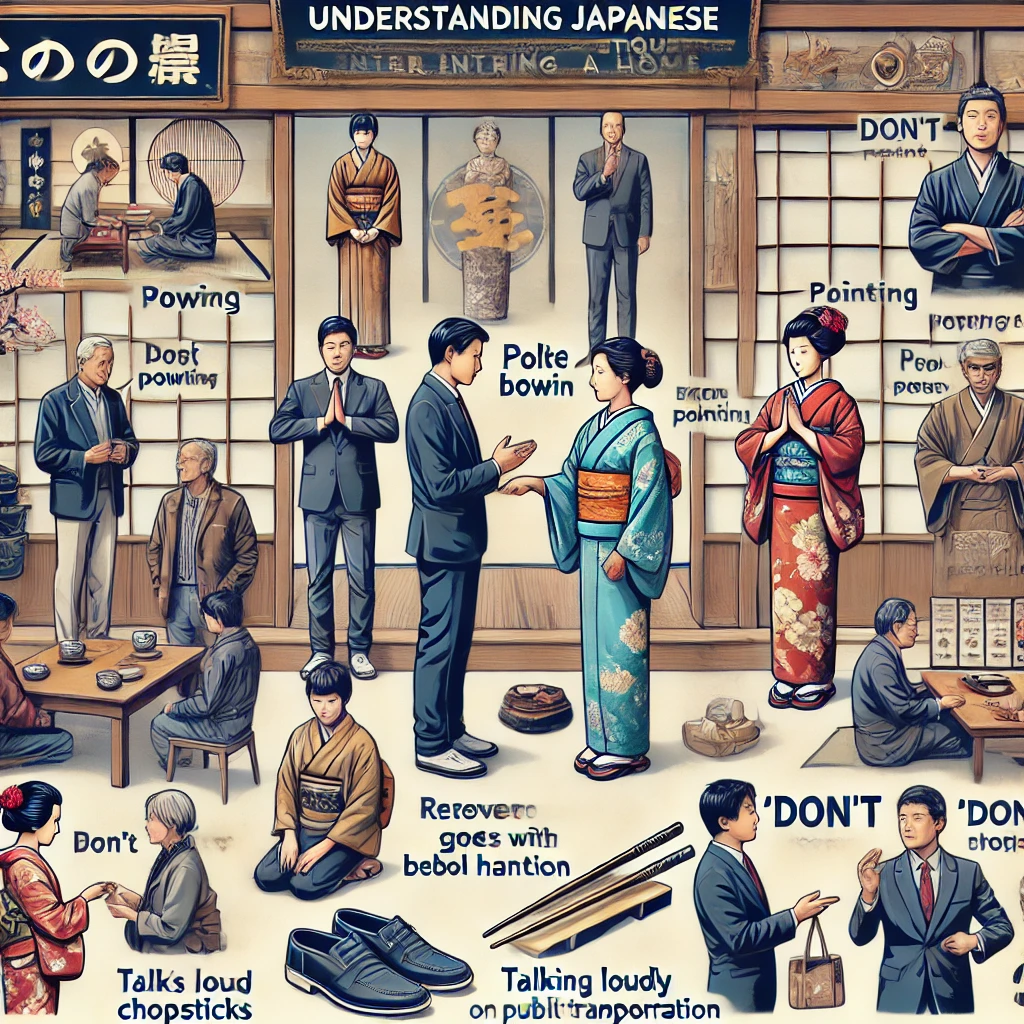Table of Contents
Introduction to Japanese Etiquette
Etiquette in Japan is a vital aspect of the culture, deeply rooted in respect and consideration for others. It reflects the values that dominate Japanese society, where social harmony and order are prioritized. Understanding Japanese etiquette is essential for visitors, as it not only enhances interpersonal interactions but also fosters a sense of belonging and respect within the community. Unlike many Western cultures where formality may be less emphasized, Japan’s customs often dictate a specific set of behaviors and protocols that must be observed.
One significant element of Japanese etiquette is the profound appreciation for politeness and humility. Greetings, such as bowing, signify respect and acknowledgement of the other person. This practice illustrates how etiquette in Japan serves as a means of expressing gratitude and reverence in everyday interactions. Moreover, certain behaviors, such as removing shoes before entering a home, further exemplify the Japanese emphasis on cleanliness and respect for personal space.
Cultural differences can create challenges in social settings, particularly for those unfamiliar with Japanese customs. Misunderstandings or inadvertent breaches of etiquette can lead to unintentional offense. For example, the manner in which gifts are exchanged, the protocol for dining, and the appropriate use of language can vary significantly from Western norms. Consequently, visitors who take the time to learn and adapt to these cultural nuances are more likely to enjoy a positive experience in Japan.
In essence, understanding Japanese etiquette is crucial for anyone wishing to immerse themselves in the rich cultural tapestry of Japan. By respecting the social customs and norms, visitors can engage more effectively with the local community, fostering goodwill and mutual understanding during their stay.

Greeting Etiquette: Bowing and Introductions
Understanding the intricacies of greeting etiquette in Japan is essential for visitors wishing to navigate social interactions respectfully. One of the most notable aspects of Japanese greetings is the practice of bowing, which varies in depth and style depending on the context, relationship, and formality of the situation. Typically, a shallow bow at a 15-degree angle is considered a casual greeting, while a deeper bow, around 30 degrees, signifies greater respect. In formal circumstances, such as meeting a superior or during ceremonial events, a bow of up to 45 degrees is expected. For visitors, it is vital to observe these nuances, as failing to bow correctly can be perceived as a sign of disrespect.
When making introductions, the Japanese place a significant emphasis on politeness and humility. The standard format for introducing oneself involves stating one’s name followed by the phrase “douzo yoroshiku onegaishimasu,” which roughly translates to “please treat me well.” This expression implies a mutual agreement of respect and consideration between the individuals involved. In cases where visitors are introduced to someone else, the person making the introduction typically presents the names clearly, followed by the same phrase to foster connection and mutual respect among all parties.
Using appropriate language during introductions is equally critical. When introducing someone of higher status or seniority, it is customary to mention their title or affiliation first, followed by their name. Appropriate honorifics, such as “san” after a name, further demonstrate respect in conversation. Visitors should also be mindful of their body language, maintaining eye contact and a polite demeanor, which enhance the overall respectful interaction characteristic of Japanese culture.
Dining Etiquette: Dos and Don’ts at the Table
Dining etiquette in Japan reflects a rich cultural history and emphasizes respect and harmony during meals. Understanding the dos and don’ts is essential for visitors who wish to immerse themselves in the local customs. Using chopsticks correctly is one of the crucial aspects. It is considered polite to hold chopsticks towards the thicker end and not to stick them into a bowl of rice, as this resembles funeral rites. Instead, place them on the provided rest when not in use.
Another vital practice is the verbal expression of gratitude before and after the meal. Saying ‘itadakimasu’ before eating signifies appreciation for the food, while ‘gochisousama’ is said after the meal to thank the host and chefs for the sustenance. Neglecting these phrases may be viewed as impolite or disrespectful, undermining the communal spirit of dining in Japan. It is also important to remember that slurping noodles is not only accepted but encouraged, as it conveys enjoyment of the meal.
Visitors should also be mindful of how to handle dishes. When dining, it is preferable to finish all the food served on one’s plate, as leaving food can imply that the meal was unsatisfactory. In Japan, it is common to share food in a round setting. Using the serving utensils provided is essential, as using one’s chopsticks to serve food is frowned upon. As for tipping, it is generally not practiced in Japan, and leaving gratuities can lead to confusion or offense. Instead, express gratitude verbally and with polite behavior.
By adhering to these dining etiquette dos and don’ts, visitors will not only enjoy their meals but also demonstrate respect for Japanese culture, fostering a deeper appreciation for this unique dining experience.
Gift-Giving Customs: Understanding Omiyage
In Japan, the tradition of gift-giving, known as omiyage, holds both cultural significance and deep-rooted meaning. Omiyage refers to souvenirs or gifts that travelers bring back from their trips, particularly for family, friends, or colleagues. This practice is not merely about the physical exchange of items; it symbolizes thoughtfulness and respect towards the recipients. Visitors to Japan should understand that omiyage is an expected part of the social fabric, reflecting the importance of relationships in Japanese culture.
When presenting omiyage, the selection of gifts is essential. Common choices include local delicacies, traditional crafts, or unique items representative of the place visited. Such gifts are often small yet meaningful, representing the traveler’s experience and appreciation for their hosts. It is important to note that while the gift itself is crucial, the presentation matters significantly as well. Gifts are typically wrapped beautifully, adhering to meticulous standards which reflect care and respect. Plain or simple wrapping may be perceived as lackluster, so investing in attractive presentation is advisable.
The timing of gift-giving also plays a critical role in the custom of omiyage. It is customary to present gifts at the beginning of a visit or upon returning from a trip, showcasing the desire to share experiences and memories. When visiting someone’s home, bringing a small gift for the host is also strongly encouraged, representing gratitude for their hospitality. It is essential to offer the gift with both hands and to express the sentiment behind it sincerely.
Understanding the nuances of omiyage will allow visitors to engage more meaningfully with Japanese culture, demonstrating respect and appreciation for local customs. By participating in this practice, visitors can foster deeper connections within the community and enrich their overall travel experience in Japan.
Public Behavior: Maintaining Harmony and Respect
Japan’s cultural framework is built on principles of harmony and respect, especially evident in how individuals conduct themselves in public settings. One of the most critical aspects of public behavior in Japan is the expectation of quietness, particularly on public transport systems such as trains and buses. It is customary for individuals to refrain from speaking loudly or engaging in boisterous conversations while traveling. This etiquette serves not only to ensure a peaceful environment for all commuters but also reflects the broader Japanese value of consideration for others. Passengers often engage in non-verbal communication, such as subtle nods or gestures, which helps maintain a serene atmosphere.
In addition to maintaining a quiet demeanor, personal space is another essential component of public behavior in Japan. The Japanese generally prefer to keep a respectful distance from one another in various social settings. Close physical proximity can be viewed as intrusive or disrespectful, particularly when interacting with strangers. Understanding this need for personal space is crucial for visitors, as violating this cultural norm may lead to discomfort for both parties. When navigating through crowded areas, such as in busy subway stations, it is advisable to move politely and avoid unnecessary physical contact.
Avoiding loud conversations in public places is integral to showing respect towards others and exemplifying the social harmony that is highly prized in Japanese culture. Visitors should remain aware of their volume levels and strive to blend in with the behavioral patterns of those around them. By adhering to these expected behaviors in public spaces, individuals not only demonstrate respect for their surroundings and fellow citizens but also enhance their own experiences while visiting this culturally rich nation. In conclusion, maintaining a respectful demeanor in public is vital for harmonious interactions in Japan.
Respecting Personal Space and Privacy
Personal space and privacy are essential aspects of social interactions in Japan. Understanding the significance of these concepts can greatly enhance a visitor’s experience while contributing to a respectful atmosphere. In Japanese culture, maintaining an appropriate physical distance during conversations is paramount. This distance, typically around an arm’s length, is observed as a sign of respect and consideration for the other person’s comfort. Unlike some Western cultures where closeness may signal warmth or friendliness, invading someone’s personal space in Japan can be perceived as intrusive or disrespectful.
Moreover, the concept of privacy in Japan extends beyond mere physical distance. It is deeply rooted in social etiquette, requiring individuals to be mindful of the unspoken boundaries in interpersonal communications. For example, personal topics such as one’s salary, family issues, or romantic relationships are generally avoided in both casual and professional settings. This reflects a collective mindset valuing discretion over personal revelations. Visitors are encouraged to observe and adapt to these norms by refraining from prying questions or comments that may encroach upon another’s privacy.
Situations may arise where exceptions to these boundaries are evident, particularly in crowded environments such as public transportation. In such instances, physical proximity is often unavoidable, yet it is accompanied by an implicit understanding that personal space is respected where possible. Additionally, while close friendships may permit more relaxed boundaries, acknowledging and honoring the comfort levels of acquaintances remains crucial.
Ultimately, respecting personal space and privacy in Japan showcases an understanding of cultural values, fostering positive relationships during one’s visit. Attentiveness to these social norms can enhance meaningful interactions and demonstrate an appreciation for the nuances of Japanese etiquette.
Appropriate Dress Code: What to Wear in Japan
When traveling to Japan, understanding the appropriate dress code is vital for ensuring a positive experience and displaying respect for local customs. In various settings, the expectations concerning attire may vary significantly. For business meetings, formal dress is often the norm. Men typically wear dark suits paired with a white shirt and conservative tie, while women generally opt for professional attire, which may include suits or business dresses that convey professionalism.
In more casual settings, Japanese culture still values neatness and cleanliness. Casual outings may allow for simpler clothing, but jeans and a neat shirt are a common standard that visitors should aim for. Avoiding overly casual attire like flip-flops, sweats, or torn clothing is advisable, as it may be perceived as disrespectful to local social norms. Footwear is another significant aspect; polished shoes are preferred in most public spaces, reflecting a sense of propriety and respect for cleanliness.
When attending traditional events such as weddings or tea ceremonies, wearing traditional Japanese clothing, like a kimono, is an excellent way to honor the occasion. For those unfamiliar with the kimono, opting for conservative, elegant attire is an acceptable alternative. It is also essential to pay attention to the seasonal appropriateness of clothing; lightweight, breathable fabrics are suitable for summer, while warmer layers are necessary in winter months. Adapting one’s wardrobe to these cultural expectations demonstrates an understanding of Japan’s rich traditions and values.
Respecting the dress code enhances a visitor’s experience and fosters goodwill between cultures. By choosing attire wisely, tourists can navigate various social settings with ease, leaving a positive impression on their hosts and locals alike.
Navigating Cultural Sites: Behaviors to Follow
Japan is renowned for its deep-rooted cultural heritage, especially in its countless shrines and temples. Visitors to these sites must adopt behavior that resonates with the local customs to ensure a respectful and meaningful experience. Among the first etiquettes to observe is the practice of bowing upon entering a shrine. This gesture, though simple, signifies respect and appreciation for the sacred space. A slight yet intentional bow can foster a connection with the cultural significance of the location.
Another critical practice involves removing one’s shoes before entering certain areas, especially within temples and traditional accommodations, such as ryokans. This practice stems from a long-standing cultural norm emphasizing cleanliness and respect. Visitors should look for designated shoe storage areas, and if unsure, it is always polite to ask before entering. Moreover, it is essential to adhere to specific signs or local guidance regarding which areas require shoes to be removed, as these can vary from place to place.
Maintaining a respectful demeanor while observing rituals and practices is equally crucial. This involves refraining from loud conversations, taking photos where prohibited, and minimizing any disruptions to ongoing ceremonies or activities. When participating in certain rituals—such as making offerings or purifying oneself with water—familiarizing oneself with the proper procedures beforehand can greatly enhance one’s experience. Additionally, tourists should strive to dress appropriately, as many cultural sites have dress codes that reflect their significance and sanctity.
Understanding and practicing these behaviors not only demonstrates respect for Japanese traditions but also enriches one’s visit to cultural sites, fostering a deeper appreciation for the history and spirituality inherent in these remarkable places.
Conclusion: Embracing Cultural Differences
As we navigate through the intricacies of Japan’s etiquette, it becomes evident that understanding these social norms is essential for anyone visiting this remarkable country. Japan’s rich cultural landscape is shaped by centuries of tradition and subtlety; therefore, a mere appreciation of its sights and sounds does not suffice. Engaging with the local customs enhances one’s travel experience and fosters mutual respect and understanding between visitors and Japanese nationals.
By embracing the unique aspects of Japanese etiquette, visitors can create more meaningful interactions with locals. Simple gestures, such as bowing in greeting, using the proper honorifics, and observing dining etiquette, can significantly enrich one’s experience and help avoid unintended faux pas. Such awareness not only reflects respect for the host culture but also shows a willingness to adapt and learn from different lifestyles.
Furthermore, cultivating an open-minded attitude towards cultural differences allows for deeper connections. Understanding that practices may vary significantly from one’s own culture enables visitors to navigate social situations more effectively. This adaptability is invaluable, particularly when encountering unfamiliar traditions and customs, which are an integral part of the Japanese experience. It is crucial to approach these differences not as obstacles but as opportunities for personal growth and cultural exchange.

In conclusion, by dedicating time and effort to learn about and respect Japanese etiquette, travelers can enhance their journeys. They contribute to a harmonious cross-cultural dialogue, fostering goodwill and understanding. The rewards of engaging respectfully with Japan’s customs extend far beyond the trip itself, providing lasting memories and insights that enrich one’s perspective on global diversity.





